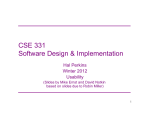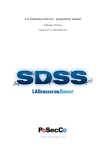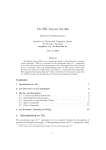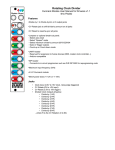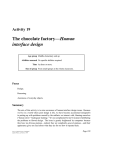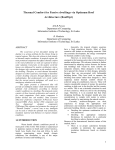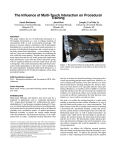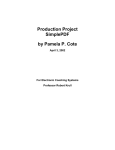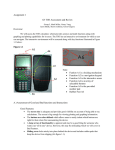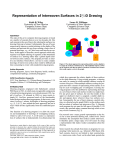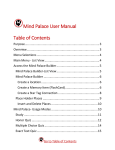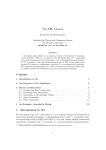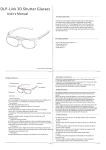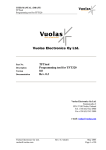Download Quiz 1
Transcript
6.831 User Interface Design & Implementation Fall 2004 Quiz 1 This quiz is closed book, closed notes. You have 80 minutes to complete it. Your name: ___________________________________________________ 1. (3 points) Which of the following are measurable dimensions of usability? (check all that apply) _X_ Learnability _X_ Efficiency ___ Price _X_ Error rate _X_ Response time _X_ Satisfaction 2. (3 points) Assuming all of the following statements are true, which is least likely to be revealed by user and task analysis? A. Files are rarely renamed. B. A car must be washed before it can be waxed. C. The 3D game interface you’ve designed makes some users nauseous. D. Some users know the model number of the product they want. E. A restaurant kitchen is a noisy place. Choose one: __C___ User testing might reveal the nausea problem after you’ve built the interface. But user and task analysis precedes construction of the interface. 3. (4 points) Louis Reasoner says, “People can’t keep more than 7+/-2 letters in working memory.” In what sense is he right, and in what sense is he wrong? Working memory does store 7 +/- 2 chunks, and a letter is one kind of chunk. But chunks aren’t always letters. A person might be able to rearrange many letters into a few memorable chunks – e.g., words. For the questions on this page, suppose you’re going to design and implement an alarm clock especially for blind users. 4. (3 points) Give one reason in favor of using the waterfall model in this case, and one reason in favor of iterative design. Alarm clocks are well-understood devices with many decades of iteration behind their requirements and user interfaces, so a waterfall model might be reasonable for an alarm clock. But an alarm clock designed for blind users may be less well-understood, and the developers (who probably aren’t blind) may not be as familiar with a blind person’s requirements and capabilities. 5. (3 points) Explain what participatory design means in this case. A blind person is an active participant on the design team, not just a test subject. 6. (3 points) Describe how a low-fidelity prototype might be made for this case. Physical materials like cardboard, styrofoam, or clay for prototyping the feel and tactile output of the alarm clock. Sound effects like bells or human voice to prototype the audio interface. 7. (3 points) Give one way that the Olympic Message System used iterative design. The user manual underwent 200 iterations. 8. (3 points) User-centered design is defined by three principles, one of which is iterative design. What are the other two principles? (1) early focus on users; (2) continual evaluation. 9. (3 points) List at least two different user classes of a conventional coin-operated soda machine. One possible answer: soda buyers, and the machine’s loader. 10. (4 points) Name the parts of the MVC pattern and give the primary responsibility of each part. Model: responsible for application data View: responsible for display Controller: responsible for handling input 11. (3 points) List all the places that the observer pattern appears in the MVC pattern. View is an observer of the model. Controller is (sometimes) an observer of the model. 12. (4 points) List three ways that the view hierarchy is used in a GUI toolkit. Output: automatic redraw, automatic clipping, z-order, coordinate systems Input: event dispatch and propagation. Automatic layout. 13. (3 points) Which of the following are related to working memory? (check all that apply) __X___ Elaborative rehearsal __X___ Maintenance rehearsal ______ Perceptual fusion ______ Open-loop motor control __X___ Chunking 14. (4 points) Assuming the mouse pointer starts at point M, rank the buttons A, B, C, and D by speed of access. ___B___ slowest ___D___ ___C___ ___A___ fastest A M 0 2 B 4 5 7 9 15. (3 points) Color blindness is caused by a problem in the A. Lens B. Retina C. Iris D. Aqueous humor Choose one: ___B_____ D C 15 16 24 The questions on this page use the view hierarchy shown below. The hierarchy is shown on the left, and its screen appearance is shown on the right. A B C A D B D E E C 16. (4 points) The mouse button is pressed somewhere inside E. List the views that can receive this mouse-press event, in order. E, D, A. 17. (4 points) Suppose view E moves in such a way that its x coordinate doubles. (Assume that the toolkit is Swing, and that view A fills the entire screen.) List the views that are redrawn, in the order that they are drawn. Be careful! When E’s x coordinate doubles it moves outside its parent’s bounding box, so it is clipped – no longer visible on the screen. Thus the only damaged part of the screen is E’s original location, which requires redrawing (in order): A, C, D. 18. (3 points) Ben Bitdiddle complains that his user interface flickers when the user drags objects around the screen. Which technique can he use to fix this problem? A. Double-buffering B. Antialiasing C. Subpixel rendering D. Event coalescing E. Alpha compositing Choose one: __A_____ 19. (4 points) Draw the HSV color model and label each dimension with its full name. See the Lecture 5 notes. 20. (3 points) Give two ways that the Unix rm command (which deletes files) fails to meet the definition of a direct manipulation interface. (1) no continuous visible representation (2) doesn’t use physical actions or presses of labeled buttons (4) results are not immediately visible (3) results are not easily reversible 21. (3 points) Explain why red-on-blue text is hard to read. Chromatic aberration. The lens must focus differently for different wavelengths of light, and since red and blue are on different ends of the visible spectrum, the boundary between red and blue looks fuzzy. 22. (4 points) Define internal, external, and metaphorical consistency. (You don’t need to give examples.) internal: consistency with other parts of the same interface external: consistency with other interfaces on the same platform metaphorical: consistency with a real-world metaphor 23. (4 points) Give two reasons why hand-drawn prototypes are good in the early stages of design. (1) cheap to make (2) easy to throw away (3) users focus on issues that are important in the early stages, rather than irrelevant details like color or font 24. (3 points) Which of the following is least likely to be revealed by a paper prototype? A. Your users don’t know the term algorithm. B. Toolbar buttons are too small to press. C. A particular dialog box should be nonmodal, because users need to access information under it. D. The Help menu isn’t in the right place. Choose one: ___B_____ For the questions on this page, consider the Microsoft Windows window-resizing interface, circled below: Discuss the advantages or disadvantages of this interface with respect to the following principles: 25. (3 points) Affordances The three grooved lines offer an affordance for grasping. 26. (3 points) Natural mapping The control is located directly on the corner that it will resize. Dragging it outward or inward resizes the window in the same direction. 27. (3 points) Feedback The mouse cursor changes to a double-headed arrow when it hovers over the corner. When the corner is dragged, the window shows immediate feedback about the new size of the window (either as a wire frame or by resizing the actual window). 28. (3 points) Give one general technique for making a mode less error-prone. Make it temporary; Make it spring-loaded, like the Shift key; Make it more visibly apparent 29. (3 points) Which of the following statements is not true about the UI toolkit described in the paper “Glyphs: Flyweight Objects for User Interfaces”? A. Individual text characters are represented as components. B. Glyphs support automatic layout. C. A glyph must store its screen position. D. Glyphs are components (as opposed to strokes or pixels). Choose one: ___C___ 30. (4 points) State 5 of Nielsen’s 10 heuristics. (Their names are enough.) (1) Match the real world (2) Consistency (3) Help & documentation (4) User control & freedom (5) Flexibility & efficiency (6) Visibility of system status (7) Error prevention (8) Recognition, not recall (9) Error diagnosis, reporting, and recovery (10) Aesthetic and minimalist design END OF QUIZ













